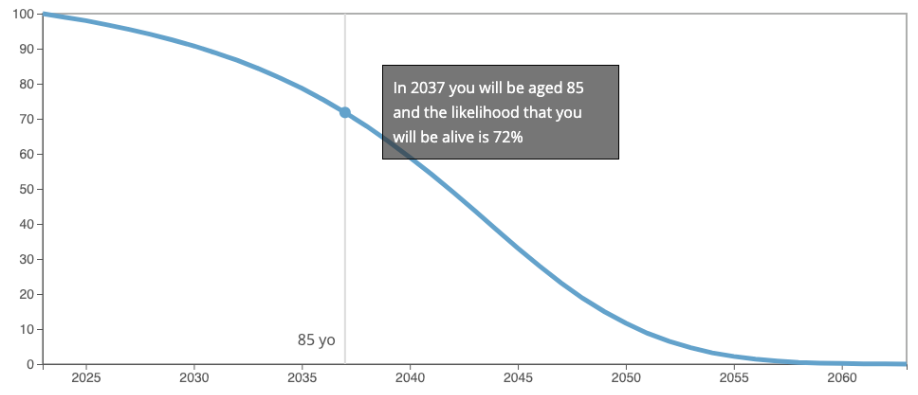How Long Will I Live?
Calculating Your Life Expectancy
The most important fact when planning retirement funding is not your savings, but how long they will need to last. This can lead to stress for many retirees who are concerned about running out. But this stress can be managed quite easily by using reliable information to more accurately predict your own life expectancy – as well as that of your partner.
Life expectancy is a statistical measure of the average lifespan of a population. It is calculated by taking the average age at death of a group of people born in the same year and subtracting the number of years that have passed since their birth. For example, if a group of people born in 2023 have a life expectancy of 75 years, then half of them are expected to die before they reach the age of 75 and half are expected to live beyond that age.
Factors which influence your life expectancy include:
- Gender: Women generally have a higher life expectancy than men.
- Country of birth: Life expectancy varies from country to country, with high-income countries having higher life expectancies than low-income countries.
- Income: People with higher incomes tend to have longer life expectancies than people with lower incomes.
- Education: People with higher levels of education tend to have longer life expectancies than people with lower levels of education.
- Healthcare: Countries and regions with better healthcare systems tend to have higher life expectancies.
- Lifestyle factors: Smoking, obesity, and lack of physical activity can all shorten life expectancy.
The recently released Retirement Essentials Life Expectancy calculator has been designed to show you the probabilities of you living to or beyond the average life expectancy. We offer these calculators for both singles and for couples as this information can richly inform the timespan you wish to plan for when it comes to funding your retirement.
Life expectancy has been increasing steadily over the past few centuries. In 1800, the global life expectancy was just 35 years. By 2019, it had reached 73 years. This increase is due to a number of factors, including improvements in healthcare, sanitation, and nutrition.
There is still a lot of variation in life expectancy around the world. In 2019, the highest life expectancy was in Japan, at 84.2 years. The lowest life expectancy was in Sierra Leone, at 54.1 years.
Life expectancy is a useful measure of the health of a population. It can be used to track progress over time and to compare different populations. However, it is important to remember that life expectancy is just an average. There will always be people who live longer and people who die sooner.
We show your life expectancy, based on the Australian population, in a chart. For single people we show a single line that illustrates the probability of the average person of your age and gender to be alive in a given year.

For couples, we show four lines. Each shows the probability of an average couple of your ages to be alive under different circumstances.

The value of using the tool will enable you to plan realistically for your future when taking into account your estimated life expectancy.
Here’s a link to the Retirement Essentials Life Expectancy calculator so you can see the probability of your own (hopefully) longer life. This information can quickly and easily be used in conjunction with a Retirement Forecast consultation so you are dealing with more accurate forecasts of financial needs. The consultation will help you work out how long your money will last under a range of different life expectancy scenarios.

How long will you live?
The team at Retirement Essentials has worked hard to produce a calculator that helps you move beyond the ‘how long is a piece of string’ guess work many retirees struggle with. Here’s what you need to know about life expectancy and how to calculate your own so you can then create more accurate retirement income forecasts.
Is long life simply the result of good genes?
There are many factors that influence your life expectancy. None of them, happily, are set in stone and there is a lot we can do at any age to improve our chances of living longer. It’s also important to understand the difference between being alive and being active. A recent article in Fortune magazine explains the difference between healthspan and lifespan.
It states that,‘Lifespan is the number of years someone lives from birth until death, while healthspan is the number of years someone is healthy without chronic and debilitating disease. The earliest mentions of healthspan describe it as, ‘the maintenance of full function as nearly as possible to the end of life.’
Most of us would like to remain fit and active for as long as possible, so concentrating on healthspan is an essential ingredient in ensuring quality of life.
Free Life Expectancy Calculator
As Seen On






